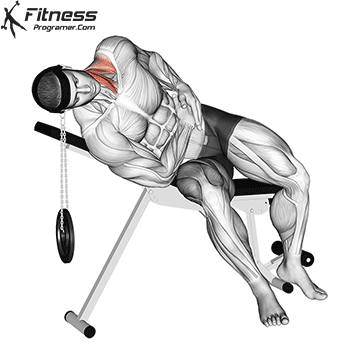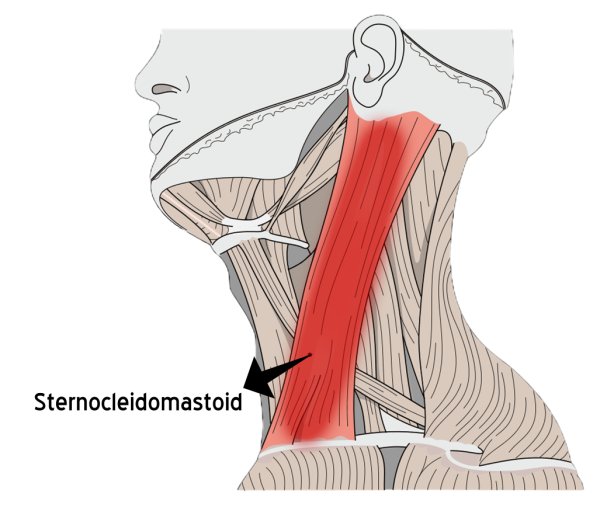Overview of Weighted Lateral Neck Flexion
Weighted Lateral Neck Flexion on an incline bench is an exercise that targets the lateral muscles of the neck, specifically the sternocleidomastoid and scalene muscles. Thanks to its strong neck muscles, it makes the neck much more versatile, increasing the range of motion, relaxing the neck and making it strong against injuries. This exercise is particularly beneficial for athletes involved in sports that require strong neck muscles, such as football, rugby, wrestle, MMA, or other combative sports.
How to do:

Starting Position:
- Securely strap the head harness to your head and attach a weight plate to it.
- Lie on your side on an incline bench with your head extending off the end.
- Lower the weight plate suspended by the head harness over the floor.
- Lower your head until you feel a mild stretch in the opposite side of your neck.
Execution:
- Exhale as you slowly and carefully lift the weight plate by laterally flexing your neck.
- Hold the position for a count of one or two.
- Inhale as you slowly and carefully lower the weight plate to the starting position.
Repetitions:
- Repeat the exercise for the prescribed number of repetitions.
- Repeat on the opposite side.
Comments and Tips:
- Do not laterally flex your neck beyond feeling a mild stretch.
- Keep the movement slow and under full control.
- Use light weights to avoid straining your neck.
- Ensure the weight plate does not touch the floor during the exercise.
- Instead of lying on your arm, you can place your hand on the floor off the end of the bench.
- If you don’t have a head harness, you can hold a small weight plate on the side of your head. Use a towel for comfort.
Weighted Lateral Neck Flexion / Benefits
- Muscle Strengthening:
- The exercise primarily targets the lateral muscles of the neck, including the sternocleidomastoid and scalene muscles. By using resistance, such as a weighted head harness or plate, you can effectively strengthen these muscles.
- Improved Neck Stability:
- Strengthening the neck muscles contributes to enhanced stability. A stable neck is important for maintaining proper head alignment, reducing the risk of injury, and providing support during various activities.
- Reduced Risk of Neck Injuries:
- Having a strong neck can help reduce the risk of neck injuries, especially in sports or activities where impact or collisions are common. The increased stability can provide better protection against sudden movements or forces.
- Enhanced Range of Motion:
- Weighted lateral neck flexion can help improve the flexibility and range of motion of the neck. This can be particularly beneficial for individuals who may experience stiffness or limited movement in the neck.
- Posture Improvement:
- Strengthening the muscles involved in lateral neck flexion can contribute to improved overall posture. This is important for maintaining proper alignment of the spine and reducing the likelihood of developing poor posture-related issues.
- Alleviation of Neck Tension:
- Engaging in neck exercises, including lateral flexion with added weight, can help release tension in the neck muscles. This may be especially beneficial for individuals who experience tightness or discomfort in the neck.
- Assistance in Respiration:
- Certain neck muscles, such as the scalene muscles and sternocleidomastoid, play a role in respiration. Strengthening these muscles through targeted exercises may contribute to improved breathing quality.
- Versatility for Athletes:
- Athletes in sports like football, rugby, soccer, MMA, or other combative sports may find the exercise beneficial for developing a strong and resilient neck, which is crucial for withstanding physical impacts.
- Overall Neck Health:
- Regular incorporation of neck exercises, including weighted lateral neck flexion, into a comprehensive fitness routine contributes to overall neck health. This is essential for maintaining a strong and functional neck throughout one’s life.
Weighted Lateral Neck Flexion / Muscles Worked
Here’s a breakdown of the muscles worked during weighted lateral neck flexion:

- Sternocleidomastoid (SCM):
- The sternocleidomastoid is a large muscle located on each side of the neck. It has two heads, one originating from the sternum (sterno-) and the other from the clavicle (cleido-). The SCM functions to flex the neck forward, laterally flex the neck to the side, and rotate the head to the opposite side.
- Scalene Muscles:
- The scalene muscles are a group of three pairs of muscles (anterior, middle, and posterior) located on each side of the neck. They assist in various movements, including lateral flexion of the neck, elevation of the first two ribs during inhalation, and rotation of the neck.
- Synergists – Splenius:
- The splenius muscles, which include the splenius capitis and splenius cervicis, act as synergists in the lateral neck flexion exercise. These muscles are located in the upper and posterior neck and are involved in extending and rotating the head and neck.
- Synergists – Trapezius, Upper:
- The upper fibers of the trapezius muscle also act as synergists in this exercise. The trapezius is a large, triangular muscle that extends from the base of the skull down to the middle of the back. The upper fibers assist in movements such as elevating the scapula and extending the neck.
